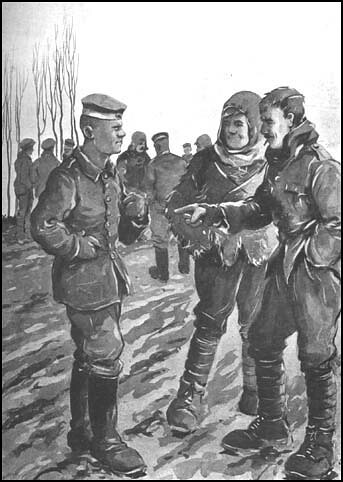World War I was a horrific catastrophe that changed the world forever. It was warfare on a scale never before imagined, combining new and terrifying technologies such as planes, tanks, and poison gas with misfit, outmoded tactics that guaranteed maximum casualties in a trench-hell of filth, shells, and death.  Yet on Christmas day, 1914, something wonderful, though short-lived, happened:
Yet on Christmas day, 1914, something wonderful, though short-lived, happened:
Although the popular memory of World War One is normally one of horrific casualties and ‘wasted’ life, the conflict does have tales of comradeship and peace. One of the most remarkable, and heavily mythologised, events concerns the ‘Christmas Truce’ of 1914, in which the soldiers of the Western Front laid down their arms on Christmas Day and met in No Man’s Land, exchanging food and cigarettes, as well as playing football. The cessation of violence was entirely unofficial and there had been no prior discussion: troops acted spontaneously from goodwill, not orders. Not only did this truce actually happen, but the event was more widespread than commonly portrayed. There are many accounts of the Christmas truce, the most famous of which concern the meeting of British and German forces; however, French and Belgium troops also took part. The unofficial nature of the truce meant that there was no one single cause or origin; some narratives tell of British troops hearing their German counterparts singing Christmas carols and joining in, while Frank Richards, a private in the Royal Welch Fusiliers, told of how both sides erected signs wishing the other a ‘Merry Christmas’. From these small starts some men crossed the lines with their hands up, and troops from the opposing side went to meet them. By the time officers realised what was happening the initial meetings had been made, and most commanders either turned a blind eye or happily joined in. The fraternisation lasted, in many areas, for the whole of Christmas day. Food and supplies were exchanged on a one to one basis, while in some areas men borrowed tools and equipment from the enemy, in order to quickly improve their own living conditions. Many games of football were played using whatever would suffice for a ball, while bodies that had become trapped within No Man’s Land were buried. Most modern retellings of the Truce finish with the soldiers returning to their trenches and then fighting again the next day, but in many areas the peace lasted much longer. Frank Richard’s account explained how both sides refrained from shooting at each other the next day, until the British troops were relieved and they left the front line. In other areas the goodwill lasted for several weeks, bringing a halt to opportunistic sniping, before the bloody conflict once again resumed.
[Cross-posted on The Thinklings]
